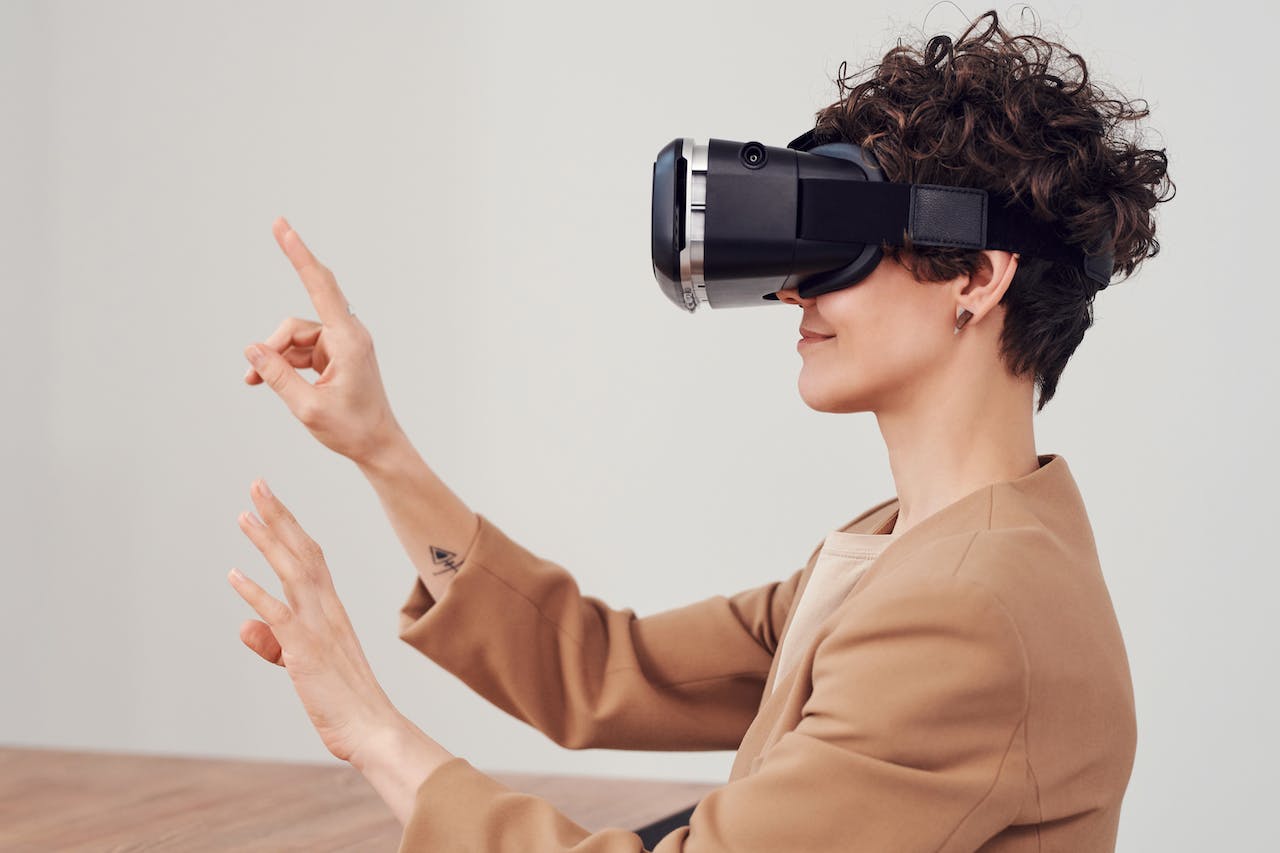
The world of technology is constantly evolving, and one of the most exciting frontiers is virtual reality (VR). As VR continues to permeate various industries, from gaming and entertainment to healthcare and education, investors are keeping a keen eye on the companies driving this revolutionary technology forward. In this article, you will explore the best virtual reality stocks to buy now, shedding light on the key players shaping the future of immersive experiences.
What Is Virtual Reality?
Virtual Reality (VR) refers to a computer-generated simulation of a three-dimensional (3D) environment or experience that can be interacted with and explored by an individual.
In VR, users are typically immersed in a synthetic, digital environment, often through the use of specialized hardware such as VR headsets or goggles. The goal is to create a convincing and immersive sensory experience that can simulate the real world or transport users to fantastical, computer-generated realms.
Grand View Research projects that the worldwide virtual reality industry will develop at a 15% compound annual growth rate, or CAGR, between 2022 and 2030.
Headsets And Hardware
VR Headsets
Specialized devices are worn on the head that includes displays to present the virtual environment to the user. These headsets may also incorporate sensors for tracking head movements, providing a sense of presence and immersion.
Input Devices
Controllers or gloves are equipped with sensors that allow users to interact with and manipulate objects in the virtual world.
Immersive Environments
VR aims to create a sense of presence and immersion by surrounding users with a simulated environment that responds to their movements and actions.
Sensory Feedback
Some advanced VR systems include haptic feedback, providing users with a sense of touch or feedback in response to their interactions within the virtual environment.
360-Degree Content
VR experiences often involve 360-degree visuals and sound, allowing users to look in any direction and hear audio from different angles, enhancing the feeling of being present in a different world.
Applications Across Industries
VR has applications in various industries beyond entertainment, including healthcare (medical simulations and therapy), education (virtual classrooms and training), gaming, architecture (virtual walkthroughs), military training, and more.
Augmented Reality (AR) Vs. Virtual Reality (VR)
While VR immerses users entirely in a digital environment, Augmented Reality (AR) overlays digital content into the real world. Both technologies fall under the umbrella term Extended Reality (XR).
Development Platforms
Various software and game development platforms, such as Unity and Unreal Engine, are widely used for creating VR content.
Virtual reality has evolved significantly over the years, and ongoing technological advancements continue to improve the realism and accessibility of VR experiences. As technology becomes more mainstream, it is increasingly influencing how people interact with digital content and the way industries approach training, education, entertainment, and more.
Pros Of Virtual Reality Stocks
Potentially-transformative Technology
For many tech investors, it's the ambition to be among the first to invest in a technology that will transform the world. While there's no assurance that virtual reality (VR) will have the same widespread economic effect as computers, the internet, or smartphones, investors will want to be there if it does.
The success of AR-enabled social media applications like TikTok and Snapchat indicates that there is a general interest in the technology.
Blue-chip Stocks With Solid Performance
With virtual reality, this is different. Typically, betting on an emerging technology involves making high-risk investments in start-up businesses.
The majority of the businesses on the list, as mentioned above, are the large-cap tech firms that have contributed to the S&P 500's gain throughout the last 12 months. Although they still carry some risks, they are much more stable than the average startup.
Cons Of Virtual Reality Stocks
Potentially A Fad
VR technology may follow in the footsteps of smartphones and PCs, but it may also follow in the footsteps of cryptocurrencies and NFTs. The VR market has had its share of booms and busts, including periods when broad adoption seemed inevitable but never materialized. It's too soon to rule out such a scenario with Meta and Apple's following goods.
Interest Rate Sensitivity
In 2022, a number of large tech stocks, some of which are included in the table above, saw a decline in share prices due to rising interest rates that increased the cost of servicing the businesses' colossal debt loads.
VR stocks may be severely impacted if inflation turns out to be more persistent than anticipated and the Federal Reserve chooses to hike rates once again.
6 Best Virtual Reality Stocks To Buy Now
Starting in late 2021, virtual reality equities began to plummet, with some experiencing severe losses. 2022 was a challenging year for technology in general. Raising rates in response to soaring inflation brought about a quick 180-degree turnaround for a previously booming industry.
Investor money departed the industry in large quantities as the euphoria crashed off a cliff and the reality of Fed rate rises set in. Nevertheless, investors should still think about the considerable potential that VR stocks currently have.
Meta Platforms Inc. (META)
The first person to bring up VR in a conversation should be Meta Platforms, previously Facebook. CEO Mark Zuckerberg said that AI and the metaverse continue to be the company's top goals at the company's fourth quarter 2022 earnings presentation. He referred to them as the "two major technical waves driving your roadmap," both now and in the future.
In its Q1 2023 financial report, Meta spoke more about artificial intelligence than the metaverse, but it is still spending money on virtual reality. In the first quarter, the company reported an operating loss of about $4 billion, up from nearly $3 billion in the previous quarter.
Sony
Sony created the PlayStation VR, or virtual reality headgear, which is compatible with their well-known PlayStation video game systems. Although it wasn't nearly as impressive as the Meta Quest 2 when it came out in 2020, it was still one of the best-selling VR headsets when it was released in 2016. But with the PlayStation VR 2, Sony eventually revised the almost six-year-old design in 2023.
The initial price of the PlayStation VR 2 was $550 when it was released in February 2023, which is much more than the $400 starting price of the first PSVR. However, adoption is maintained by the more fantastic price. Sales of the PlayStation VR 2 over the first six weeks were 8% higher than those of the first PSVR, according to an investor presentation.
Apple
Apple's stock has done very well in 2023. VR hasn't directly caused it. Growth has yet to be the cause, too. In actuality, Apple's decline in the entire Q3 fiscal year persisted. Sales of iPhones are declining, which is a sign that people have less money than they once had for pricey technology. That ought to force AAPL stock prices to decrease.
No, they haven't. Apple has too many factors working in its favor, making it just too vast and significant. Investors are attributing all of this to Apple. This includes India, a growing market in which Apple is making significant investments. It also involves a growing capacity to increase service income. It is thus one of those VR stocks to take into account.
Microsoft Corporation
The competition between Apple and Microsoft has long influenced the computer sector. With Apple being the iPhone business and Microsoft concentrating on games (XBOX) and corporate services (cloud, Office 365, Team, LinkedIn, etc.), this had all but gone out. The VR tech period may bring the two enemies to blows once again. Microsoft has a presence in the market with their Hololens.
Most notably, in a $21.9 billion agreement, Microsoft delivered 120,000 machines to the US military. New revised versions of the gadget, lighter and more combat-ready, are being tested since the agreement has been sluggish to materialize. Perhaps the first use of virtual reality will not include video games or virtual offices but rather the creation of fully functional cyber warriors, something that would seem more fitting for a science fiction book.
Nvidia Corp. (NVDA)
The high-quality visuals produced by Nvidia's GPUs have the potential to make virtual reality more alluring. This is due to the possibility that GPUs made by Nvidia will power the reality-based graphics simulations in virtual reality. Currently, the company's GPUs hold almost 80% of the market. Compared to rival Advanced Micro Devices Inc. (AMD), which only has a 20% market share, this is a significant increase.
As of June 15, the NVDA stock has gained about 200% for the year after a roughly 42% loss in 2022. Of course, there are a ton of additional benefits to owning NVDA, including its participation in innovative sectors like driverless cars and artificial intelligence. VR is a simple addition that investors can make to NVDA's already strong investment thesis.
Unity Software Inc. (U)
As "the world's leading platform for creating and operating interactive, real-time 3D (RT3D) content," Unity Software was recently recognized by Fast Company as one of the most inventive businesses in the world. It's developing VR games that allow users to compete in real time in order to live up to this reputation. With the assistance of qualified designers, the business is constructing the metaverse's architectural framework.
This includes some previously popular games, such as the augmented reality game Pokemon Go, as well as a brand-new series of lectures and workshops to encourage developers.
The company's most fantastic day since going public, U shares shot up 26% in a single day when Apple announced that it is collaborating with the developer on games and applications for the VisionOS platform. With that upward trend, the stock broke out of a significant resistance level and reached a price it hasn't been at since last year.
Frequently Asked Question
Is VR A Good Investment?
Over the next ten years, analysts predict significant growth in the sector. Between 2023 and 2030 or later, a number of research organizations predict a compound annual growth rate ranging from 14% to 31%.
What Companies Are Leading In Virtual Reality?
The leaders in the augmented reality and virtual reality space are none other than IT giants Microsoft Corporation (NASDAQ: MSFT), Alphabet Inc. (NASDAQ: GOOG), and Apple Inc. (NASDAQ: AAPL).
Is VR A Future?
Virtual reality has the potential to transform interpersonal communication completely. We could eventually be able to have face-to-face virtual interactions with anybody, wherever in the world.
Is VR A Growing Market?
Virtual reality (VR) seeks to provide the user with a multisensory experience, which may include sight, touch, hearing, smell, or even taste. The worldwide VR market is expected to rise from less than 12 billion US dollars in 2022 to more than 22 billion US dollars by 2025, indicating how quickly the sector is expanding.
Is VR In High Demand?
Many different sectors are seeing an increase in demand for VR headsets, including Gaming. Since VR headsets provide a more realistic and immersive gaming experience, more and more people are using them for gaming.
Are VR Companies Profitable?
Revenue from virtual reality (VR) for consumers and businesses reached 11.97 billion USD in 2022, up from the previous year. Revenues from virtual reality are predicted to increase to 15.81 billion dollars in 2023.
Which Country Invented VR?
In 1968, American computer scientist Ivan Sutherland and his student Bob Sproull constructed the first virtual reality headgear.
Which Country Uses VR The Most?
China is the country that spent the most on AR and VR in 2020. With nearly $5.8 billion spent on this technology, the nation has a 38% market share in the worldwide AR/VR industry. The US spends the most after it, at around $5.1 billion.
What Fortune 500 Companies Are Using VR?
Among the Fortune 500 firms that have entered the metaverse are Nestlé, Siemens, Audi, Porsche, Deutsche Telekom, and others. Realizing the promise of virtual reality, they want to lead the way in this emerging technology.
What Are The 3 Types Of VR?
Non-immersive, semi-immersive, and fully immersive virtual reality simulations are the three main types now in use.
Can You Get A Job In VR?
There are many careers in virtual reality. In general, employment for VR developers, VR engineers, and VR designers exists, but there are other options as well. For example, you may work as a technical artist, UI/UX designer, or 3D modeler. This is by no means a comprehensive list.
Conclusion
The virtual reality market is poised for substantial growth, driven by advancements in hardware and software and the increasing adoption of VR across diverse industries. While the stocks highlighted in this article as the best virtual reality stocks to buy now represent compelling opportunities, the landscape is dynamic, and investors should stay vigilant for emerging players and disruptive technologies that could shape the future of virtual reality investing.



